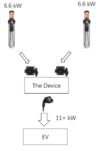CandS This is an interesting theoretical discussion. I thought of the same thing awhile ago as it might be really handy to shorten time at L2 stations.
There's a couple ways to approach this, first the easiest is to order a 20kW Setec portable DC fast charger, they offer them with both a Chademo and CCS combo connector but what's really cool is now they now offer a Tesla connector! As the old chademo Tesla adapter has been discontinued and is expensive and not all the cars can do CCS yet without upgrades from and performed at Tesla I'm really happy to see Setec offered the Tesla plug. You have to ask them to customize it when you order it and tell them you want two power inputs, their 20 kW portable actually has two 10 kilowatt units inside, you would then use a simple j1772 to Nema 1450 adapter, actually a pair of them to feed the Setec, however their not cheap for about 8-10k, high watt AC to DC converters never are.
One of the methods described above is similar to what a quick 220 power supply can do by grabbing the hot phase off at each cable (l2 actually has two already) to make 240 this won't work for a number of reasons, first of all the j-1772 spec requires GFI protection inside EVSE's so without returning the current back to the correct charging station you will end up tripping it's GFI so you can't use a quick 220 type power supply idea and you can't parallel up the hot phases from each connector.
This would be simpler with an EV conversion you could simply use two on board AC Chargers and have them go to one port on each side of the car so you truly have a dual Chargers.
The second option for use with an OEM EV, what you're going to need is two isolation Transformers, what this will allow you to do is play with the secondaries, that's the output of the Transformers, and do whatever you want without affecting what's going on with the input side, this will also keep the GFI circuits happy as each charging station is basically just driving a Transformer, each Transformer is going to have to be the rated at least what charging station in the wild would be, so let's say it's a common chargepoint those put out 30 amps you're lucky if it's on 240 volts instead of 208 volts commercial power so that's 7.2 KW so you need two transformers that can do 7.2 kilowatts continuous that's not going to be cheap but there's a company... Maddox Transformers, I believe they're called that wholesale used Transformers so you'll be able to get a way better price there. What you're looking for are one-to-one isolation Transformers but those products typically aren't in such a large size so the thing to go after at this point is a couple 240 volt to 120v step down Transformers, the 240 being the primary side you would then take the two 120 volt secondaries and put them in series to give yourself the 240 volts you want. You will be able to pull 14.4kW with this setup (approx 240v at 60amps) The transformers output would feed a large L2 EVSE like a GEN 2 wall connector that is set to twice what ever the public stations are offering and there you go. Your EV does have to have an onboard charger to use this much amperage, my 2018 MS 100D can for example (72amps) but most Tesla's were 40amps, now 48amps is their standard. The F-150 Lightning ER can accept 80amps! If you don't have a large on-board charger then Option #1 with the Setec is what you would have to use.



